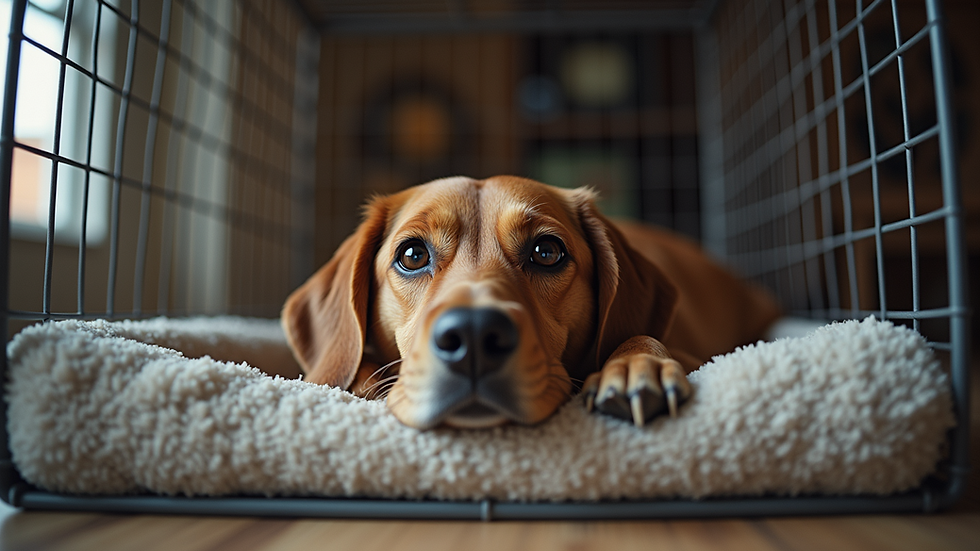Top-Rated Dog Crates: Expert Recommendations
- Woof Worthy Crates

- Aug 18
- 4 min read
Choosing the right crate for your dog is essential for their comfort, safety, and training success. With so many options available, it can be overwhelming to find the perfect fit. This guide will walk you through the top-rated dog crates on the market, highlighting their features, benefits, and what to consider before making a purchase. Whether you have a small puppy or a large adult dog, these expert recommendations will help you make an informed decision.
What Makes a Dog Crate Top-Rated?
When selecting a crate, several factors determine its quality and suitability. A top-rated dog crate should be:
Durable and sturdy: It must withstand chewing and scratching.
Well-ventilated: Proper airflow keeps your dog comfortable.
Easy to clean: Removable trays or washable materials are ideal.
Safe and secure: Strong locks and no sharp edges prevent injuries.
Appropriately sized: Your dog should have enough room to stand, turn, and lie down comfortably.
Many crates also offer additional features like foldability for travel, double doors for easy access, and divider panels for growing puppies.
Types of Dog Crates
Wire crates: Provide excellent ventilation and visibility. They are lightweight and collapsible but may not offer much privacy.
Plastic crates: Often used for travel, these crates are enclosed and provide a den-like environment.
Soft-sided crates: Lightweight and portable, suitable for calm dogs and indoor use.
Heavy-duty crates: Made from metal or reinforced materials, ideal for strong chewers or escape artists.

Wire crates offer great ventilation and visibility for dogs.
Top-Rated Dog Crates for Every Need
Here are some of the best dog crates available, each excelling in different categories:
Best for versatility and affordability
Available in multiple sizes
Easy to fold and transport
Includes a removable plastic tray for cleaning
Double door design for flexible placement
This crate is a favorite among dog owners for its balance of quality and price. It’s perfect for both home use and travel.
Best for air travel and durability
Made of heavy-duty plastic with metal door
Airline-approved for most carriers
Ventilated on all sides
Secure locking system
If you plan to fly with your dog, this crate meets airline requirements and ensures your pet’s safety during transit.
Best for indoor use and portability
Lightweight and easy to set up
Mesh windows for ventilation
Suitable for calm dogs or short-term use
Comes with a carrying bag
Soft-sided crates are ideal for small dogs or temporary containment but are not recommended for dogs that chew or scratch.
Best for escape-proof and rugged use
Made from rotomolded plastic with steel reinforcements
Waterproof and weather-resistant
Locking system with multiple latches
Suitable for outdoor adventures and strong dogs
This crate is designed for durability and security, perfect for dogs that require extra protection.

Heavy-duty crates provide maximum security for strong dogs.
Best budget-friendly option
Lightweight and foldable
Includes a removable plastic tray
Available in various sizes
Simple design with basic features
For those on a budget, this crate offers essential features without compromising on quality.
For more detailed reviews and options, check out this comprehensive list of dog crates.
What's the Longest You Should Leave a Dog in a Crate For?
Crate time should be carefully managed to ensure your dog’s well-being. Leaving a dog in a crate for too long can cause stress, anxiety, and physical discomfort.
Puppies under 6 months: Should not be crated for more than 3-4 hours at a time. Their bladders are small, and they need frequent bathroom breaks.
Adult dogs: Can typically stay in a crate for up to 6-8 hours, but this depends on the dog’s temperament and health.
Senior dogs or dogs with medical issues: May require more frequent breaks and shorter crate times.
Always provide water, a comfortable bed, and toys to keep your dog occupied. Avoid using the crate as a form of punishment. Instead, make it a positive and safe space.

Dogs should have a comfortable and safe environment inside their crate.
How to Choose the Right Size Crate for Your Dog
Selecting the correct size is crucial for your dog’s comfort and safety. A crate that is too small can cause discomfort, while one that is too large may not provide the cozy den-like feeling dogs prefer.
Measuring Your Dog
Length: Measure from the tip of the nose to the base of the tail.
Height: Measure from the floor to the top of the head or ears (whichever is higher).
Size Guidelines
Add 2-4 inches to the length and height measurements to determine the crate size.
For puppies, consider crates with divider panels to adjust the space as they grow.
If you have multiple dogs, provide separate crates for each to avoid stress.
Additional Tips
If your dog is between sizes, choose the larger crate for comfort.
Consider the crate’s purpose: travel crates may need to be more compact, while home crates can be roomier.
Tips for Introducing Your Dog to a Crate
Introducing a crate should be a gradual and positive experience. Here are some steps to help your dog adjust:
Make it inviting: Place soft bedding and favorite toys inside.
Use treats: Encourage your dog to enter the crate with treats and praise.
Start with short periods: Begin with a few minutes and gradually increase the time.
Feed meals in the crate: This creates a positive association.
Avoid forcing: Never push or drag your dog into the crate.
Patience and consistency are key. Over time, your dog will see the crate as a safe and comfortable space.
Choosing the right crate is an investment in your dog’s happiness and safety. By considering your dog’s size, temperament, and lifestyle, you can find a crate that meets all your needs. For a wide selection of trusted options, explore the best dog crates available today.

Creating a cozy environment helps dogs feel secure in their crate.




Comments